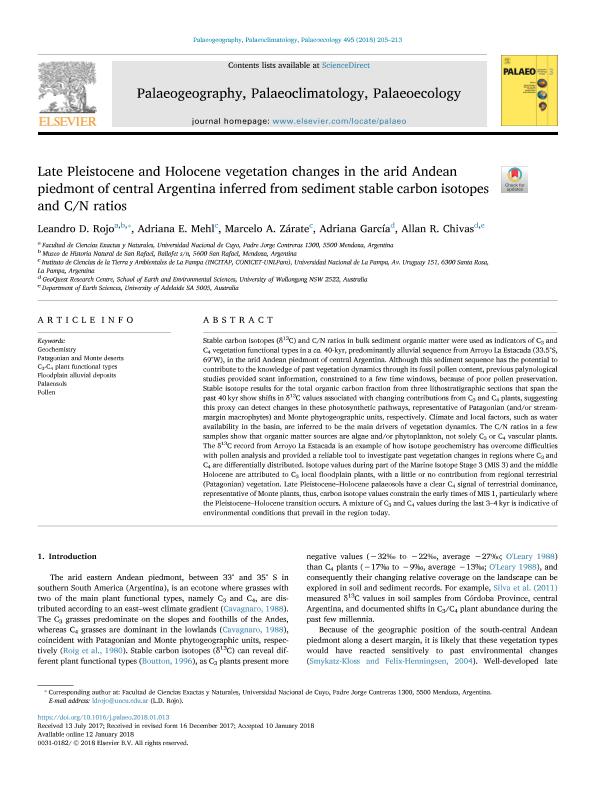Artículo
Late Pleistocene and Holocene vegetation changes in the arid Andean piedmont of central Argentina inferred from sediment stable carbon isotopes and C/N ratios
Rojo, Leandro David ; Mehl, Adriana Ester
; Mehl, Adriana Ester ; Zárate, Marcelo Arístides
; Zárate, Marcelo Arístides ; García, Adriana; Chivas, Allan R.
; García, Adriana; Chivas, Allan R.
 ; Mehl, Adriana Ester
; Mehl, Adriana Ester ; Zárate, Marcelo Arístides
; Zárate, Marcelo Arístides ; García, Adriana; Chivas, Allan R.
; García, Adriana; Chivas, Allan R.
Fecha de publicación:
04/2018
Editorial:
Elsevier Science
Revista:
Palaeogeography, Palaeoclimatology, Palaeoecology
ISSN:
0031-0182
Idioma:
Inglés
Tipo de recurso:
Artículo publicado
Clasificación temática:
Resumen
Stable carbon isotopes (δ13C) and C/N ratios in bulk sediment organic matter were used as indicators of C3 and C4 vegetation functional types in a ca. 40-kyr, predominantly alluvial sequence from Arroyo La Estacada (33.5°S, 69°W), in the arid Andean piedmont of central Argentina. Although this sediment sequence has the potential to contribute to the knowledge of past vegetation dynamics through its fossil pollen content, previous palynological studies provided scant information, constrained to a few time windows, because of poor pollen preservation. Stable isotope results for the total organic carbon fraction from three lithostratigraphic sections that span the past 40 kyr show shifts in δ13C values associated with changing contributions from C3 and C4 plants, suggesting this proxy can detect changes in these photosynthetic pathways, representative of Patagonian (and/or stream-margin macrophytes) and Monte phytogeographic units, respectively. Climate and local factors, such as water availability in the basin, are inferred to be the main drivers of vegetation dynamics. The C/N ratios in a few samples show that organic matter sources are algae and/or phytoplankton, not solely C3 or C4 vascular plants. The δ13C record from Arroyo La Estacada is an example of how isotope geochemistry has overcome difficulties with pollen analysis and provided a reliable tool to investigate past vegetation changes in regions where C3 and C4 are differentially distributed. Isotope values during part of the Marine Isotope Stage 3 (MIS 3) and the middle Holocene are attributed to C3 local floodplain plants, with a little or no contribution from regional terrestrial (Patagonian) vegetation. Late Pleistocene–Holocene palaeosols have a clear C4 signal of terrestrial dominance, representative of Monte plants, thus, carbon isotope values constrain the early times of MIS 1, particularly where the Pleistocene–Holocene transition occurs. A mixture of C3 and C4 values during the last 3–4 kyr is indicative of environmental conditions that prevail in the region today.
Archivos asociados
Licencia
Identificadores
Colecciones
Articulos(INCITAP)
Articulos de INST.D/CS D/L/TIERRA Y AMBIENTALES D/L/PAMPA
Articulos de INST.D/CS D/L/TIERRA Y AMBIENTALES D/L/PAMPA
Citación
Rojo, Leandro David; Mehl, Adriana Ester; Zárate, Marcelo Arístides; García, Adriana; Chivas, Allan R.; Late Pleistocene and Holocene vegetation changes in the arid Andean piedmont of central Argentina inferred from sediment stable carbon isotopes and C/N ratios; Elsevier Science; Palaeogeography, Palaeoclimatology, Palaeoecology; 495; 4-2018; 205-213
Compartir
Altmétricas



